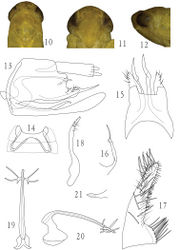Dayus trifurcatus
| Notice: | This page is derived from the original publication listed below, whose author(s) should always be credited. Further contributors may edit and improve the content of this page and, consequently, need to be credited as well (see page history). Any assessment of factual correctness requires a careful review of the original article as well as of subsequent contributions.
If you are uncertain whether your planned contribution is correct or not, we suggest that you use the associated discussion page instead of editing the page directly. This page should be cited as follows (rationale):
Citation formats to copy and paste
BibTeX: @article{Yu2013ZooKeys355, RIS/ Endnote: TY - JOUR Wikipedia/ Citizendium: <ref name="Yu2013ZooKeys355">{{Citation See also the citation download page at the journal. |
Ordo: Hemiptera
Familia: Cicadellidae
Genus: Dayus
Name
Dayus trifurcatus Yu & Yang sp. n. – Wikispecies link – ZooBank link – Pensoft Profile
Description
Length, male 4.5–4.6 mm, female 4.7–4.8 mm.
General color yellowish.
Male ventral abdominal apodemes reaching segment 4 (Fig. 14). Male pygofer with dorsoposterior margin strongly sinuate (Fig. 13); ventral appendage expanded at distal 2/3, thereafter abruptly tapering to spine-like apex (Figs 13, 16). Subgential plate abruptly expanded laterobasally about twice as broad basally than distally; with 11 lateral macrosetae in basal group, an oblique line of 17 macrosetae and several long fine setae subbasally to apex and ca.35 short microsetae at outer margin (Fig. 17). Paramere as in Fig. 18. Aedeagus shaft very long and narrow, cylindrical, nearly straight in lateral view, with a subapical trifurcate process on each side, branches slender (Figs 19, 20). Anal tube process relatively long (Fig. 21).
Type materials
Holotype male. China: Beipei, Chongqing, 6 May 2008, coll. Zaihua Yang. Paratypes, 13♂♂, 5♀♀, same data as holotype (GUGC and 1♂, 1♀ in BMNH).
Etymology
The new speciesnamealludes to the trifurcate processes of the aedeagus.
Remarks
Thenew species can be distinguished mainly by the strongly sinuate posterior margin of the pygofer and shape of the aedeagal shaft and configuration of its process as noted in the description.
Original Description
- Yu, X; Yang, M; 2013: Three new species of the leafhopper genus Dayus Mahmood from China (Hemiptera, Cicadellidae, Typhlocybinae, Empoascini) ZooKeys, 355: 1-8. doi
Images
|

